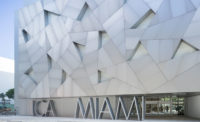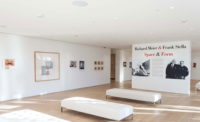Architects Set the Scene at Design Miami
With installations by Bjarke Ingels and David Adjaye, dealers serving up Le Corbusier, and parties in prominent buildings, the design fair puts architecture in the spotlight.
 |
| Image courtesy Fred A. Bernstein |
|
Design Miami's 2011 Designer of the Year, David Adjaye, stands with the installation that he contributed to the fair. |

Kitchen-sink bookcases by LOT-EK installed in Mark McDonald's booth.
Bjarke Ingels seems to be everywhere these days, so it's a surprise to learn that he had never been to Miami Beach before. "It's a lot like Tel Aviv," the Danish architect said, referring to the cities' white stucco expanses. Ingels sipped Veuve Clicquot at the opening of the Design Miami fair (where his installation framed a concept car from Audi), then headed to a party sponsored by Ferrari a few blocks away in the Herzog & de Meuron-designed parking garage, 1111 Lincoln Road.
Each December, when Art Basel descends on Miami Beach, the 10-year-old art fair and its satellite exhibitions bring hordes of collectors to town. Purveyors of luxury goods follow, promoting cars, champagnes, and, these days, architecture. In addition to architect-designed objects for sale at the fairs, there are installations by prominent designers and parties in showpiece buildings making architecture a big part of the spectacle.
On the second night of the design fair, David Adjaye showed up for a "design talk" at which Lord Norman Foster reminisced about his idol R. Buckminster Fuller. (Foster has collected, and restored, a number of Fuller's works, a passion he shares with real estate developer and Design Miami impresario Craig Robins.) Outside the Design Miami tent, Adjaye posed in front of his own installation'a kind of cave made out of hundreds of wooden planks, hung vertically, with an interior reminiscent of a geodesic dome. "Bucky's voids are important'it's a very conscious echo," said Adjaye affably. (The commission to design the pavilion came with Adjaye's coronation as the fair's Designer of the Year, a title once held by Zaha Hadid).
In terms of new architecture, the city had nothing to rival last year's near-simultaneous openings of the Herzog & de Meuron's garage and Frank Gehry's New World Symphony building. (H & de M's Miami Art Museum is finally under construction, promising a sensation a few years hence.) But architects were everywhere at the design fair; items for sale included a couple of ingenious kitchen-sink bookcases by New York firm LOT-EK hanging in a booth designed by Harry Allen for the dealer Mark McDonald, a Design Miami newbie.
But the scene stealer was Ingels' installation, a steeply banked floor studded with LEDs that responded to footsteps with glowing color fields. Revelers treated it as a dance floor, but architecture buffs knew it was a prototype of a road surface that alerts drivers to pedestrian movement'one of Ingels' transportation initiatives (which he described at RECORD's Innovation conference in New York last month.) "Come back when it's less crowded," Ingels said, watching the floor fill up with partiers.
There was plenty of furniture for sale at the design fair, but architecture was also on offer. One of the Design Miami exhibitors, Paris dealer Jousse Enterprise, proffered a section of Jean Prouve's 1957 Ecole de Villejuif. More surprising (and perhaps more disturbing), Galerie Patrick Seguin, also based in Paris, featured metal louvers, constructed like airplane wings, from the Chandigarh complex by Le Corbusier and Pierre Jeanneret. As Lord Foster admired the gallery's contents, this writer screwed up his courage and asked the Pritzker Prize winner whether he was sad to see pieces of Le Corbusier's masterpiece sold piecemeal. "Thank God someone cared enough to save them," said Foster without missing a beat. "Otherwise, they could have ended up in the trash."





